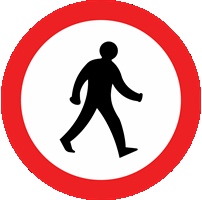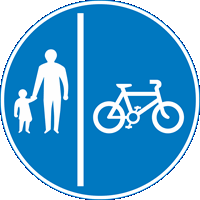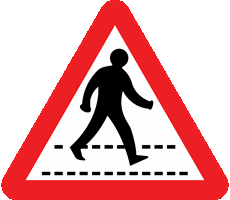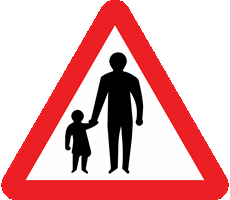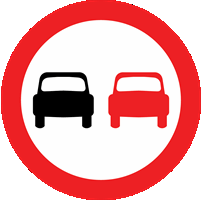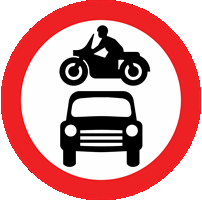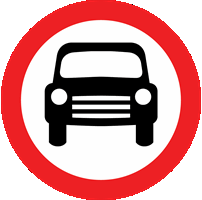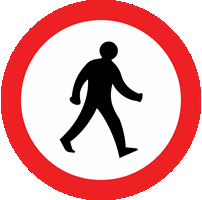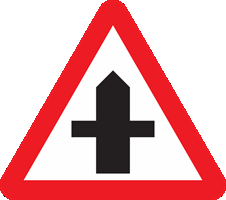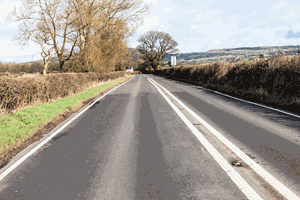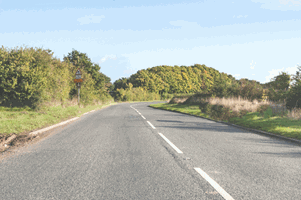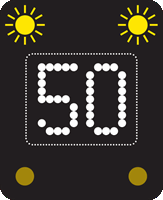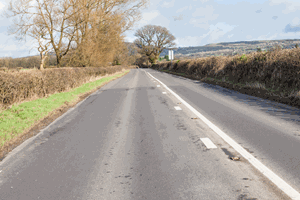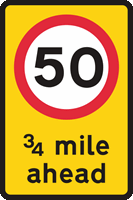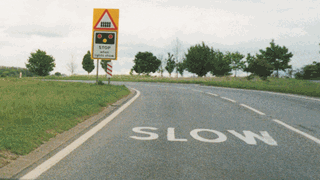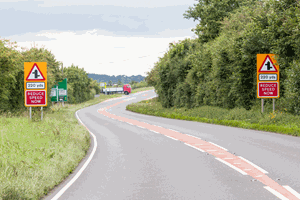You have 57 minutes to answer 50 multiple choice driving theory test questions. You need to answer at least 43 out of 50 questions correctly to pass. You can review your answer after each question or you can review all of your answers at the end of the test. Best of luck!
Test Quick View
Click on an answer to view the correct choice along with the explanation.
Correct Answer: D
Explanation: Be tolerant of older drivers. They may take longer to react to a hazard and they may be hesitant in some situations - for example, at a junction.
Explanation: Be tolerant of older drivers. They may take longer to react to a hazard and they may be hesitant in some situations - for example, at a junction.
Correct Answer: D
Explanation: Always check the road signs. Triangular signs are warning signs: they inform you about hazards ahead and help you to anticipate any problems. There are a number of different signs showing pedestrians. Learn the meaning of each one.
Explanation: Always check the road signs. Triangular signs are warning signs: they inform you about hazards ahead and help you to anticipate any problems. There are a number of different signs showing pedestrians. Learn the meaning of each one.
Correct Answer: A
Explanation: You can overtake other traffic on either side when travelling in a one-way street. Make full use of your mirrors and ensure it's clear all around before you attempt to overtake. Look for signs and road markings, and use the most suitable lane for your destination.
Explanation: You can overtake other traffic on either side when travelling in a one-way street. Make full use of your mirrors and ensure it's clear all around before you attempt to overtake. Look for signs and road markings, and use the most suitable lane for your destination.
Correct Answer: B
Explanation: This sign is used to enable pedestrians to walk free from traffic. It's often found in shopping areas.
Explanation: This sign is used to enable pedestrians to walk free from traffic. It's often found in shopping areas.
Correct Answer: B
Explanation: The priority through the junction is shown by the broader line. You need to be aware of the hazard posed by traffic crossing or pulling out onto a major road.
Explanation: The priority through the junction is shown by the broader line. You need to be aware of the hazard posed by traffic crossing or pulling out onto a major road.
Correct Answer: B
Explanation: You may cross the solid white line to pass a stationary vehicle or to pass a pedal cycle, horse or road maintenance vehicle if it's travelling at 10 mph or less. You may also cross the solid white line to enter a side road or access a property.
Explanation: You may cross the solid white line to pass a stationary vehicle or to pass a pedal cycle, horse or road maintenance vehicle if it's travelling at 10 mph or less. You may also cross the solid white line to enter a side road or access a property.
Correct Answer: D
Explanation: Road markings will warn you of a hazard ahead. A single broken line along the centre of the road, with long markings and short gaps, is a hazard warning line. Don't cross it unless you can see that the road is clear well ahead.
Explanation: Road markings will warn you of a hazard ahead. A single broken line along the centre of the road, with long markings and short gaps, is a hazard warning line. Don't cross it unless you can see that the road is clear well ahead.
Correct Answer: C
Explanation: Look out for signs above your lane or on the central reservation. These will give you important information or warnings about the road ahead. To allow for the high speed of motorway traffic, these signs may light up some distance from any hazard. Don't ignore the signs just because the road looks clear to you.
Explanation: Look out for signs above your lane or on the central reservation. These will give you important information or warnings about the road ahead. To allow for the high speed of motorway traffic, these signs may light up some distance from any hazard. Don't ignore the signs just because the road looks clear to you.
Correct Answer: C
Explanation: You mustn't park or stop on a road marked with double white lines (even where one of the lines is broken) except to pick up or set down passengers.
Explanation: You mustn't park or stop on a road marked with double white lines (even where one of the lines is broken) except to pick up or set down passengers.
10. You're following two cyclists. They approach a roundabout in the left-hand lane. In which direction should you expect the cyclists to go? Mark one answer
AB
C
D
Correct Answer: A
Explanation: Cyclists approaching a roundabout in the left-hand lane may be turning right but may not have been able to get into the correct lane due to heavy traffic. They may also feel safer keeping to the left all the way around the roundabout. Be aware of them and give them plenty of room.
Explanation: Cyclists approaching a roundabout in the left-hand lane may be turning right but may not have been able to get into the correct lane due to heavy traffic. They may also feel safer keeping to the left all the way around the roundabout. Be aware of them and give them plenty of room.
11. You're on a motorway in fog. The left-hand edge of the motorway can be identified by reflective studs. What colour are they? Mark one answer

B
C
D
Correct Answer: C
Explanation: Be especially careful if you're on a motorway in fog. Reflective studs are there to help you in poor visibility. Different colours are used so that you'll know which lane you're in. These are
- red on the left-hand edge of the carriageway
- white between lanes
- amber on the right-hand edge of the carriageway
- green between the carriageway and slip roads
Explanation: Be especially careful if you're on a motorway in fog. Reflective studs are there to help you in poor visibility. Different colours are used so that you'll know which lane you're in. These are
- red on the left-hand edge of the carriageway
- white between lanes
- amber on the right-hand edge of the carriageway
- green between the carriageway and slip roads
Correct Answer: C
Explanation: The sign gives you an early warning of a speed restriction. If you're travelling at a higher speed, slow down in good time. You could come across queuing traffic due to roadworks or a temporary obstruction.
Explanation: The sign gives you an early warning of a speed restriction. If you're travelling at a higher speed, slow down in good time. You could come across queuing traffic due to roadworks or a temporary obstruction.
Correct Answer: A
Explanation: It may be tempting to park where you shouldn't while you run a quick errand. Careless parking is a selfish act and could endanger other road users. It's important not to park at or near a bus stop, as this could inconvenience passengers and may put them at risk as they get on or off the bus.
Explanation: It may be tempting to park where you shouldn't while you run a quick errand. Careless parking is a selfish act and could endanger other road users. It's important not to park at or near a bus stop, as this could inconvenience passengers and may put them at risk as they get on or off the bus.
Correct Answer: A
Explanation: When your vehicle is stationary, only sound the horn if you think there's a risk of danger from another road user. Don't use it just to attract someone's attention. This causes unnecessary noise and could be misleading.
Explanation: When your vehicle is stationary, only sound the horn if you think there's a risk of danger from another road user. Don't use it just to attract someone's attention. This causes unnecessary noise and could be misleading.
Correct Answer: B
Explanation: Collisions often happen at roadworks. Be aware of the speed limits, slow down in good time and keep your distance from the vehicle in front.
Explanation: Collisions often happen at roadworks. Be aware of the speed limits, slow down in good time and keep your distance from the vehicle in front.
Correct Answer: D
Explanation: You should be slowing down and selecting the correct gear in case you have to stop at the level crossing. Look for the signals and be prepared to stop if necessary.
Explanation: You should be slowing down and selecting the correct gear in case you have to stop at the level crossing. Look for the signals and be prepared to stop if necessary.
Correct Answer: C
Explanation: You should keep to the left and only use the right-hand lane if you're passing slower-moving traffic.
Explanation: You should keep to the left and only use the right-hand lane if you're passing slower-moving traffic.
18. You're travelling on a motorway in England. You must stop when signalled to do so by which of these? Mark one answer
AB
C
D
Correct Answer: B
Explanation: You'll find traffic officers on England's motorways. They work in partnership with the police, helping to keep traffic moving and helping to make your journey as safe as possible. It's an offence not to comply with the directions given by a traffic officer.
Explanation: You'll find traffic officers on England's motorways. They work in partnership with the police, helping to keep traffic moving and helping to make your journey as safe as possible. It's an offence not to comply with the directions given by a traffic officer.
Correct Answer: B
Explanation: With people's concern today for the environment, cycle routes are being extended in our towns and cities. Respect the presence of cyclists on the road and give them plenty of room if you need to pass.
Explanation: With people's concern today for the environment, cycle routes are being extended in our towns and cities. Respect the presence of cyclists on the road and give them plenty of room if you need to pass.
20. Unless signs show otherwise, what's the national speed limit for a car or motorcycle on a motorway? Mark one answer
AB
C
D
Correct Answer: C
Explanation: The national speed limit for a car or motorcycle on a motorway is 70 mph. Lower speed limits may be in force; for example, at roadworks. Variable speed limits also operate in some areas when the motorway is very busy. Cars or motorcycles towing trailers are subject to a lower speed limit.
Explanation: The national speed limit for a car or motorcycle on a motorway is 70 mph. Lower speed limits may be in force; for example, at roadworks. Variable speed limits also operate in some areas when the motorway is very busy. Cars or motorcycles towing trailers are subject to a lower speed limit.
21. You arrive at the scene of a crash. Someone is bleeding badly from an arm wound. Nothing is embedded in it. What should you do? Mark one answer
AB
C
D
Correct Answer: B
Explanation: If possible, lay the casualty down. Check for anything that may be in the wound. Apply firm pressure to the wound using clean material, without pressing on anything that might be in it. Raising the arm above the level of the heart will also help to stem the flow of blood.
Explanation: If possible, lay the casualty down. Check for anything that may be in the wound. Apply firm pressure to the wound using clean material, without pressing on anything that might be in it. Raising the arm above the level of the heart will also help to stem the flow of blood.
Correct Answer: A
Explanation: You should overtake only when it's really necessary and you can see it's clear ahead. Look out for road signs and markings that show it's illegal or would be unsafe to overtake; for example, approaching junctions or bends. In many cases, overtaking is unlikely to significantly improve your journey time.
Explanation: You should overtake only when it's really necessary and you can see it's clear ahead. Look out for road signs and markings that show it's illegal or would be unsafe to overtake; for example, approaching junctions or bends. In many cases, overtaking is unlikely to significantly improve your journey time.
A
B
C
D
B
C
D
Correct Answer: D
Explanation: At the scene of an incident, always be aware of danger from further collisions or fire. The first priority when dealing with an unconscious person is to ensure they can breathe. This may involve clearing their airway if you can see an obstruction or if they're having difficulty breathing.
Explanation: At the scene of an incident, always be aware of danger from further collisions or fire. The first priority when dealing with an unconscious person is to ensure they can breathe. This may involve clearing their airway if you can see an obstruction or if they're having difficulty breathing.
24. At an incident, a small child isn't breathing. To restore normal breathing, how should you breathe into their mouth? Mark one answer
AB
C
D
Correct Answer: A
Explanation: If a young child has stopped breathing, first check that their airway is clear. Then give compressions to the chest using one hand (two fingers for an infant) and begin mouth-to-mouth resuscitation. Breathe very gently and continue the procedure until they can breathe without help.
Explanation: If a young child has stopped breathing, first check that their airway is clear. Then give compressions to the chest using one hand (two fingers for an infant) and begin mouth-to-mouth resuscitation. Breathe very gently and continue the procedure until they can breathe without help.
25. You're following other vehicles in fog. You have your lights on. What else can you do to reduce the chances of being in a collision? Mark one answer
AB
C
D
Correct Answer: C
Explanation: When it's foggy, use dipped headlights. This will help you see and be seen by other road users. If visibility is seriously reduced, consider using front and rear fog lights if you have them. Keep to a sensible speed and don't follow the vehicle in front too closely. If the road is wet and slippery, you'll need to allow twice the normal stopping distance.
Explanation: When it's foggy, use dipped headlights. This will help you see and be seen by other road users. If visibility is seriously reduced, consider using front and rear fog lights if you have them. Keep to a sensible speed and don't follow the vehicle in front too closely. If the road is wet and slippery, you'll need to allow twice the normal stopping distance.
Correct Answer: B
Explanation: Your headlights and tail lights help others on the road to see you. It may be necessary to turn on your lights during the day if visibility is reduced; for example, due to heavy rain. In these conditions, the light might fade before the street lights are timed to switch on. Be seen to be safe.
Explanation: Your headlights and tail lights help others on the road to see you. It may be necessary to turn on your lights during the day if visibility is reduced; for example, due to heavy rain. In these conditions, the light might fade before the street lights are timed to switch on. Be seen to be safe.
Correct Answer: B
Explanation: Traffic could be turning off or pulling out ahead of you, to the left or right. Vehicles turning left will be slowing down before the junction, and any vehicles turning right may have to stop to allow oncoming traffic to clear. Be prepared for this, as you might have to slow down or stop behind them.
Explanation: Traffic could be turning off or pulling out ahead of you, to the left or right. Vehicles turning left will be slowing down before the junction, and any vehicles turning right may have to stop to allow oncoming traffic to clear. Be prepared for this, as you might have to slow down or stop behind them.
Correct Answer: C
Explanation: You'll be putting other road users at risk if you continue to drive when you're drowsy. Pull over and stop in a safe place for a rest. Caffeinated drinks and a short nap can temporarily help counter sleepiness. If you're driving a long distance, think about finding some accommodation so you can rest for longer before continuing your journey.
Explanation: You'll be putting other road users at risk if you continue to drive when you're drowsy. Pull over and stop in a safe place for a rest. Caffeinated drinks and a short nap can temporarily help counter sleepiness. If you're driving a long distance, think about finding some accommodation so you can rest for longer before continuing your journey.
29. You want to turn right from a junction but your view is restricted by parked vehicles. What should you do? Mark one answer
AB
C
D
Correct Answer: D
Explanation: If you want to turn right from a junction and your view is restricted, stop. Ease forward until you can see - something might be approaching. If you don't know, don't go.
Explanation: If you want to turn right from a junction and your view is restricted, stop. Ease forward until you can see - something might be approaching. If you don't know, don't go.
Correct Answer: A
Explanation: When you decide to overtake a horse rider, make sure you can do so safely before you move out. Leave them plenty of room and pass slowly. Passing too closely at speed could startle the horse and unseat the rider.
Explanation: When you decide to overtake a horse rider, make sure you can do so safely before you move out. Leave them plenty of room and pass slowly. Passing too closely at speed could startle the horse and unseat the rider.
Correct Answer: D
Explanation: If your car skids and the rear wheels slide to the right, you need to steer into the skid (ie to the right), until the front and rear wheels are brought into line. Don't oversteer or you'll cause a skid in the opposite direction and this will make the situation worse.
Explanation: If your car skids and the rear wheels slide to the right, you need to steer into the skid (ie to the right), until the front and rear wheels are brought into line. Don't oversteer or you'll cause a skid in the opposite direction and this will make the situation worse.
Correct Answer: C
Explanation: Before a learner starts to drive on the road, they must have a valid provisional licence for the category of vehicle that they're driving. They must sign the licence because, without a signature, the licence isn't valid.
Explanation: Before a learner starts to drive on the road, they must have a valid provisional licence for the category of vehicle that they're driving. They must sign the licence because, without a signature, the licence isn't valid.
Correct Answer: D
Explanation: A tyre bursting can lead to a loss of control, especially if you're travelling at high speed. Using the correct procedure should help you to stop the vehicle safely.
Explanation: A tyre bursting can lead to a loss of control, especially if you're travelling at high speed. Using the correct procedure should help you to stop the vehicle safely.
Correct Answer: A
Explanation: Your tyres may be of different treads and makes. They can even be second-hand, as long as they're in good condition. They must, however, be intact, without cuts or tears. When checking the side walls for cuts and bulges, don't forget to check the side of the tyre that's hidden from view, under the car.
Explanation: Your tyres may be of different treads and makes. They can even be second-hand, as long as they're in good condition. They must, however, be intact, without cuts or tears. When checking the side walls for cuts and bulges, don't forget to check the side of the tyre that's hidden from view, under the car.
35. You're carrying two 13-year-old children and their parents in your car. Who's responsible for seeing that the children wear seat belts? Mark one answer
AB
C
D
Correct Answer: D
Explanation: Seat belts save lives and reduce the risk of injury. If you're carrying passengers under 14 years old, it's your responsibility as the driver to ensure that their seat belts are fastened or they're seated in an approved child restraint.
Explanation: Seat belts save lives and reduce the risk of injury. If you're carrying passengers under 14 years old, it's your responsibility as the driver to ensure that their seat belts are fastened or they're seated in an approved child restraint.
Correct Answer: C
Explanation: Wasting fuel costs you money and also causes unnecessary pollution. Ensuring your tyres are correctly inflated, avoiding carrying unnecessary weight and removing a roof rack that's not in use will all help to reduce your fuel consumption.
Explanation: Wasting fuel costs you money and also causes unnecessary pollution. Ensuring your tyres are correctly inflated, avoiding carrying unnecessary weight and removing a roof rack that's not in use will all help to reduce your fuel consumption.
37. Up to how much more fuel will you use by driving at 70 mph, compared with driving at 50 mph? Mark one answer
AB
C
D
Correct Answer: C
Explanation: Your vehicle will use less fuel if you avoid heavy acceleration. The higher the engine revs, the more fuel you'll use. Using the same gear, and covering the same distance, a vehicle travelling at 70 mph will use up to 30% more fuel than it would at 50 mph. However, don't travel so slowly that you inconvenience or endanger other road users.
Explanation: Your vehicle will use less fuel if you avoid heavy acceleration. The higher the engine revs, the more fuel you'll use. Using the same gear, and covering the same distance, a vehicle travelling at 70 mph will use up to 30% more fuel than it would at 50 mph. However, don't travel so slowly that you inconvenience or endanger other road users.
38. You've been involved in an argument that has made you feel angry. What should you do before starting your journey? Mark one answer
AB
C
D
Correct Answer: A
Explanation: If you're feeling upset or angry, you'll find it much more difficult to concentrate on your driving. You should wait until you've calmed down before starting a journey.
Explanation: If you're feeling upset or angry, you'll find it much more difficult to concentrate on your driving. You should wait until you've calmed down before starting a journey.
39. Your vehicle has broken down on a motorway. You aren't able to stop on the hard shoulder. What should you do? Mark one answer
AB
C
D
Correct Answer: D
Explanation: If you can't get your vehicle onto the hard shoulder, use your hazard warning lights to warn others. Leave your vehicle only when you can safely get clear of the carriageway. Don't try to repair the vehicle or attempt to place any warning device on the carriageway.
Explanation: If you can't get your vehicle onto the hard shoulder, use your hazard warning lights to warn others. Leave your vehicle only when you can safely get clear of the carriageway. Don't try to repair the vehicle or attempt to place any warning device on the carriageway.
Correct Answer: D
Explanation: Harsh braking, frequent gear changes and harsh acceleration increase fuel consumption. An engine uses less fuel when travelling at a constant low speed. You need to look well ahead so you're able to anticipate hazards early. Easing off the accelerator and timing your approach at junctions, for example, can reduce the fuel consumption of your vehicle.
Explanation: Harsh braking, frequent gear changes and harsh acceleration increase fuel consumption. An engine uses less fuel when travelling at a constant low speed. You need to look well ahead so you're able to anticipate hazards early. Easing off the accelerator and timing your approach at junctions, for example, can reduce the fuel consumption of your vehicle.
Correct Answer: B
Explanation: Emission tests are carried out to make sure your vehicle's engine is operating efficiently. This ensures the pollution produced by the engine is kept to a minimum. If your vehicle isn't serviced regularly, it may fail the annual MOT test.
Explanation: Emission tests are carried out to make sure your vehicle's engine is operating efficiently. This ensures the pollution produced by the engine is kept to a minimum. If your vehicle isn't serviced regularly, it may fail the annual MOT test.
42. You're looking for somewhere to park your vehicle. The area is full except for spaces marked 'disabled use'. What can you do? Mark one answer
AB
C
D
Correct Answer: D
Explanation: It's illegal to park in a space reserved for disabled users unless you're permitted to do so. These spaces are provided for people with limited mobility, who may need extra space to get in and out of their vehicle.
Explanation: It's illegal to park in a space reserved for disabled users unless you're permitted to do so. These spaces are provided for people with limited mobility, who may need extra space to get in and out of their vehicle.
43. You want to turn left at this junction. Your view of the main road is restricted. What should you do? Mark one answer

B
C
D
Correct Answer: A
Explanation: You should slow right down, and stop if necessary, at any junction where your view is restricted. Edge forward until you can see properly. Only then can you decide whether it's safe to go.
Explanation: You should slow right down, and stop if necessary, at any junction where your view is restricted. Edge forward until you can see properly. Only then can you decide whether it's safe to go.
44. In which conditions should you leave at least a two-second gap between your vehicle and the one in front? Mark one answer

B
C
D
Correct Answer: B
Explanation: In good, dry conditions, a driver needs to keep a distance of at least two seconds from the car in front. This should allow enough space for you to stop if the driver in front has to stop suddenly.
Explanation: In good, dry conditions, a driver needs to keep a distance of at least two seconds from the car in front. This should allow enough space for you to stop if the driver in front has to stop suddenly.
45. You're driving at night on an unlit road, following another vehicle. What should you do? Mark one answer
AB
C
D
Correct Answer: C
Explanation: If you follow another vehicle with your headlights on full beam, they could dazzle the driver. Leave a safe distance and make sure that the light from your dipped beam falls short of the vehicle in front.
Explanation: If you follow another vehicle with your headlights on full beam, they could dazzle the driver. Leave a safe distance and make sure that the light from your dipped beam falls short of the vehicle in front.
Correct Answer: D
Explanation: Avoid using your car for short journeys. On a short journey, the engine is unlikely to warm up fully and will therefore be running less efficiently. This will result in the car using more fuel and producing higher levels of harmful emissions.
Explanation: Avoid using your car for short journeys. On a short journey, the engine is unlikely to warm up fully and will therefore be running less efficiently. This will result in the car using more fuel and producing higher levels of harmful emissions.
47. How can you reduce the chances of your car being broken into when leaving it unattended? Mark one answer
AB
C
D
Correct Answer: D
Explanation: When leaving your car, take all valuables with you if you can. Otherwise, lock them out of sight.
Explanation: When leaving your car, take all valuables with you if you can. Otherwise, lock them out of sight.
48. You're driving along this motorway. It's raining. What should you do when following this lorry? Mark one answer
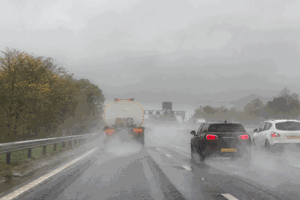
B
C
D
Correct Answer: B
Explanation: The usual two-second time gap increases to four seconds when the roads are wet. If you stay well back, you'll
- be able to see past the vehicle
- be out of the spray thrown up by the lorry's tyres
- give yourself more time to stop if the need arises
- increase your chances of being seen by the lorry driver
Explanation: The usual two-second time gap increases to four seconds when the roads are wet. If you stay well back, you'll
- be able to see past the vehicle
- be out of the spray thrown up by the lorry's tyres
- give yourself more time to stop if the need arises
- increase your chances of being seen by the lorry driver
Correct Answer: C
Explanation: By driving smoothly, you'll not only save about 15% of your fuel but will also reduce the amount of wear and tear on your vehicle and the level of pollution it produces. You're also likely to feel more relaxed and have a more pleasant journey.
Explanation: By driving smoothly, you'll not only save about 15% of your fuel but will also reduce the amount of wear and tear on your vehicle and the level of pollution it produces. You're also likely to feel more relaxed and have a more pleasant journey.
Correct Answer: A
Explanation: Don't venture out if your journey isn't necessary. If you have to travel and someone is expecting you at the other end, let them know that you'll be taking longer than usual for your journey. This will stop them worrying if you don't turn up on time and will also take the pressure off you, so you don't feel you have to rush.
Explanation: Don't venture out if your journey isn't necessary. If you have to travel and someone is expecting you at the other end, let them know that you'll be taking longer than usual for your journey. This will stop them worrying if you don't turn up on time and will also take the pressure off you, so you don't feel you have to rush.



